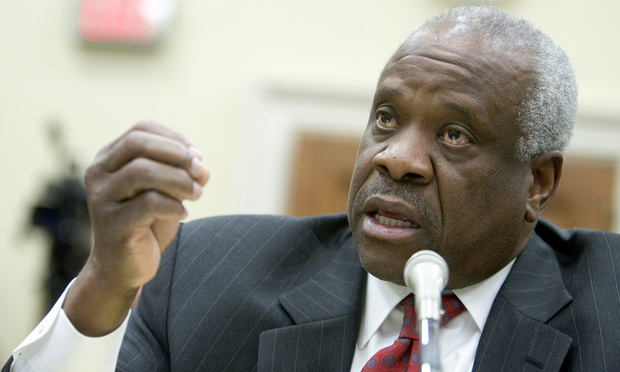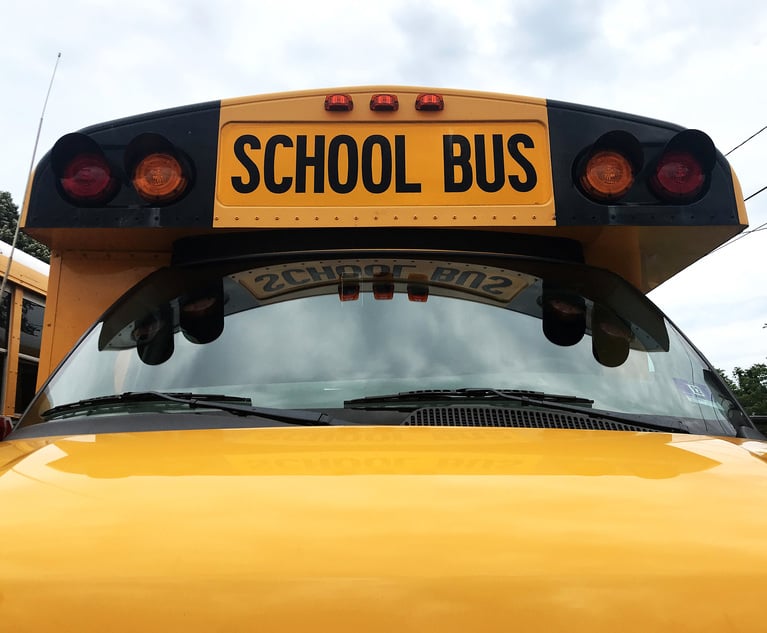Supreme Court Expands Patent Damages Beyond US Borders, Narrowly
Sidestepping the presumption against extraterritoriality, Justice Clarence Thomas' 7-2 opinion OKs damages under narrow overseas inducement statute.
June 22, 2018 at 11:53 AM
5 minute read
 Justice Clarence Thomas, U.S. Supreme Court (Photo: Diego M. Radzinschi/ ALM)
Justice Clarence Thomas, U.S. Supreme Court (Photo: Diego M. Radzinschi/ ALM) The U.S. Supreme Court issued a narrow ruling Friday on overseas patent damages. But the outcome could still have broad ramifications for U.S. patent infringement litigation.
The court ruled that an infringer found liable under Section 271(f)(2) of the Patent Act, which prohibits the shipment overseas of parts meant to be assembled into an infringing product, can be forced to pay damages for infringement that occurs outside the nation.
That's a new exception to the general rule that U.S. patent laws, including the Section 284 damages provision, apply only to domestic conduct.
“As this court has explained,” Justice Clarence Thomas wrote for a 7-2 majority in WesternGeco v. Ion Geophysical, “the 'overriding purpose' of Section 284 is to affor[d] patent owners complete compensation' for infringements,” Thomas wrote.
➤➤ Want IP news that goes deeper? Geek out with Scott Graham's email briefing, Skilled in the Art. Sign up now.
Thomas sidestepped the presumption against extraterritoriality, saying that to decide whether it applied to Section 271(f)(2) could disrupt too many other kinds of cases. Instead, under the court's RJR Nabisco framework for examining extraterritoriality, he focused on the domestic nature of the patent infringement at issue. “The conduct that Section 271(f)(2) regulates—i.e., its focus—is the domestic act of 'suppl[ying] in or from the United States,” he wrote. Therefore, damages are appropriate under Section 284, the Patent Act's damages provision.
Justice Neil Gorsuch dissented, saying no damages should be awarded for extraterritorial activity. “A U.S. patent provides a lawful monopoly over the manufacture, use, and sale of an invention within this country only,” he wrote.
Awarding damages for overseas conduct “would invite other countries to use their own patent laws and courts to assert control over our economy,” wrote Gorsuch, who was joined by Justice Stephen Breyer. “Nothing in the terms of the Patent Act supports that result and much militates against it.”
The ruling will likely lead to the reinstatement of a $93 million lost profits award for Schlumberger subsidiary WesternGeco in a dispute over mapping technology for oil deposits under the ocean floor.
WesternGeco patented methods for steering the sometimes milelong cables that scan for oil and gas deposits beneath the seabed. The company says it invested a decade of research and nearly $100 million to develop the process of “lateral steering” and held 100 percent of the market during the early 2000s. Houston-based ION manufactures a similar system that is assembled overseas then sold to WesternGeco's competitors. A Houston federal jury found that WesternGeco lost at least 10 contracts worth $6 million to $45 million each to ION-supplied competitors.
U.S. patent laws generally limit liability to making, using or selling a patented invention in the United States. The U.S. Court of Appeals for the Federal Circuit upheld the infringement finding and $22 million in royalties under Section 271(f). But the appellate court threw out the additional $93.4 million for lost profits, on the ground that those damages occurred beyond the United States.
Kirkland & Ellis partner Paul Clement had the winning argument for WesternGeco. Kirkland partner Gregg LoCascio noted that the firm has been litigating the case for nearly 10 years. "We are pleased that the Supreme Court recognized that the Patent Act affords WesternGeco and other innovators full protection against infringers who would try to skirt U.S. patent law by exporting components of a patented system for assembly abroad."
Williams & Connolly partner Kannon Shanmugam argued for Ion, while Zachary Tripp of the Solicitor General's Office argued for the U.S. government as amicus curiae.
Although Thomas' opinion was limited to Section 271(f)(2), some practitioners and scholars suggested it could lead to claims for overseas damages based on more traditional U.S. patent law provisions.
Kilpatrick Townsend & Stockton partner Matthew Holohan said he expects patent owners to use WesternGeco as the basis for “creative arguments for more expansive international damages.” As with a lot of Supreme Court patent opinions, it will play out over a few years and is hard to predict sitting here today.”
Ropes & Gray counsel Matthew Rizzolo said that since Section 284 applies to all forms of patent infringement “you could make the argument that the reasoning—not the holding—applies to other forms of patent infringement.” His Ropes colleague Rebecca Carrizosa said the issue is likely to recur “as companies and supply chains become more international.”
Emory University law professor Timothy Holbrook, who's written extensively on the presumption against extraterritoriality, thinks the court limited the reach of the decision by emphasizing the “shipping overseas” nature of infringement in Section 271(f)(2). Plus, the court declined the solicitor general's suggestion that it overrule two Federal Circuit decisions that frowned on extraterritorial damages under the more general 271(a) infringement statute.
Aside from patent law, Holbrook thought it noteworthy that the court for the first time has applied the RJR Nabisco framework to remedial provisions, rather than just liability.
University of Denver law professor Bernard Chao, who's also written on the subject, said he was disappointed in the decision, and that it represents to him “patent imperialism.”
“If other countries adopted the same kind of worldwide damages scheme,” he said, “the United States would get mad.”
This content has been archived. It is available through our partners, LexisNexis® and Bloomberg Law.
To view this content, please continue to their sites.
Not a Lexis Subscriber?
Subscribe Now
Not a Bloomberg Law Subscriber?
Subscribe Now
NOT FOR REPRINT
© 2025 ALM Global, LLC, All Rights Reserved. Request academic re-use from www.copyright.com. All other uses, submit a request to [email protected]. For more information visit Asset & Logo Licensing.
You Might Like
View All
Brownstein Adds Former Interior Secretary, Offering 'Strategic Counsel' During New Trump Term
2 minute read
Weil, Loading Up on More Regulatory Talent, Adds SEC Asset Management Co-Chief
3 minute read
FTC Sues PepsiCo for Alleged Price Break to Big-Box Retailer, Incurs Holyoak's Wrath
5 minute read
Supreme Court Will Hear Religious Parents' Bid to Opt Out of LGBTQ-Themed School Books
Trending Stories
- 1Settlement Allows Spouses of U.S. Citizens to Reopen Removal Proceedings
- 2CFPB Resolves Flurry of Enforcement Actions in Biden's Final Week
- 3Judge Orders SoCal Edison to Preserve Evidence Relating to Los Angeles Wildfires
- 4Legal Community Luminaries Honored at New York State Bar Association’s Annual Meeting
- 5The Week in Data Jan. 21: A Look at Legal Industry Trends by the Numbers
Who Got The Work
J. Brugh Lower of Gibbons has entered an appearance for industrial equipment supplier Devco Corporation in a pending trademark infringement lawsuit. The suit, accusing the defendant of selling knock-off Graco products, was filed Dec. 18 in New Jersey District Court by Rivkin Radler on behalf of Graco Inc. and Graco Minnesota. The case, assigned to U.S. District Judge Zahid N. Quraishi, is 3:24-cv-11294, Graco Inc. et al v. Devco Corporation.
Who Got The Work
Rebecca Maller-Stein and Kent A. Yalowitz of Arnold & Porter Kaye Scholer have entered their appearances for Hanaco Venture Capital and its executives, Lior Prosor and David Frankel, in a pending securities lawsuit. The action, filed on Dec. 24 in New York Southern District Court by Zell, Aron & Co. on behalf of Goldeneye Advisors, accuses the defendants of negligently and fraudulently managing the plaintiff's $1 million investment. The case, assigned to U.S. District Judge Vernon S. Broderick, is 1:24-cv-09918, Goldeneye Advisors, LLC v. Hanaco Venture Capital, Ltd. et al.
Who Got The Work
Attorneys from A&O Shearman has stepped in as defense counsel for Toronto-Dominion Bank and other defendants in a pending securities class action. The suit, filed Dec. 11 in New York Southern District Court by Bleichmar Fonti & Auld, accuses the defendants of concealing the bank's 'pervasive' deficiencies in regards to its compliance with the Bank Secrecy Act and the quality of its anti-money laundering controls. The case, assigned to U.S. District Judge Arun Subramanian, is 1:24-cv-09445, Gonzalez v. The Toronto-Dominion Bank et al.
Who Got The Work
Crown Castle International, a Pennsylvania company providing shared communications infrastructure, has turned to Luke D. Wolf of Gordon Rees Scully Mansukhani to fend off a pending breach-of-contract lawsuit. The court action, filed Nov. 25 in Michigan Eastern District Court by Hooper Hathaway PC on behalf of The Town Residences LLC, accuses Crown Castle of failing to transfer approximately $30,000 in utility payments from T-Mobile in breach of a roof-top lease and assignment agreement. The case, assigned to U.S. District Judge Susan K. Declercq, is 2:24-cv-13131, The Town Residences LLC v. T-Mobile US, Inc. et al.
Who Got The Work
Wilfred P. Coronato and Daniel M. Schwartz of McCarter & English have stepped in as defense counsel to Electrolux Home Products Inc. in a pending product liability lawsuit. The court action, filed Nov. 26 in New York Eastern District Court by Poulos Lopiccolo PC and Nagel Rice LLP on behalf of David Stern, alleges that the defendant's refrigerators’ drawers and shelving repeatedly break and fall apart within months after purchase. The case, assigned to U.S. District Judge Joan M. Azrack, is 2:24-cv-08204, Stern v. Electrolux Home Products, Inc.
Featured Firms
Law Offices of Gary Martin Hays & Associates, P.C.
(470) 294-1674
Law Offices of Mark E. Salomone
(857) 444-6468
Smith & Hassler
(713) 739-1250










